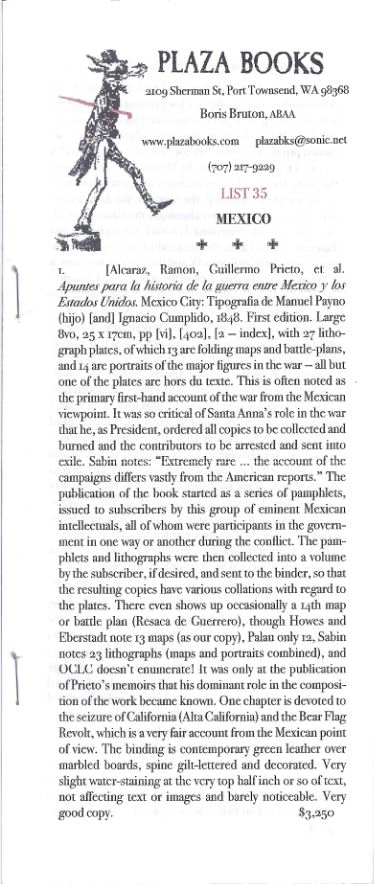Mexico is the Subject of the Latest Catalogue from Plaza Books
- by Michael Stillman

Mexico is the Subject of the Latest Catalogue from Plaza Books
Plaza Books has issued their List 35 Mexico. Mexico comes with a longer history than its larger neighbor to the north, replete with its own set of issues and controversies. Its colonial period began earlier and ended later. After independence, its leadership was not always chosen at the ballot box. It bounced back and forth between elected governments and dictatorships, and even for a brief period was controlled by a French installed emperor. It was not an easy journey, but there is no shortage of history. Some of that will be found in the books and other material found in this catalogue.
Item 8 offers a look at the ancient cities of Mexico and Central America: Les anciennes villes du Nouveau Monde. Voyages d'explorations au Mexique et dans l'Amerique centrale. Desire Charnay's account was published in Paris in 1885 (a U.S. English language edition followed in 1887). Charnay was fascinated by the travels of John Lloyd Stephens and Frederick Catherwood, who visited ancient Central American ruins around 1840. He made several journeys to Mexico and Central American from the 1850s to the 1880s. This book is a thorough and beautifully bound presentation of his findings. Priced at $2,100.
Item 23 is the first and “best” biography of Juan de Palafox y Mendoza: Vida i Virtudes del illmo. i excmo. Senor D. Juan de Palafox i Mendoza... It was written by Antonio Rosende at the behest of Palafox's friend the Cardinal of Toledo and published in 1666 (seven years after Palafox died). Palafox was sent to Mexico to serve as Bishop of Puebla, a post he held for 15 years, along with briefly holding the post of interim Archbishop. Palafox was a reformer. He took on the financial mismanagement of the local Church and the privileges afforded its officials. He believed in humane treatment of the natives, with conversion by persuasion rather than force. He also built an important library, the Biblioteca Palafoxiana. Palafox had the official support of the Pope through his battles with the local clergy, but when he took on the Jesuits, who wielded enormous power, that proved to be too much. Despite his support, the Pope still called him back to Spain, where he was given a position generally considered a demotion. Procedures to beatify Palafox were begun in the 17th century but put on hold late in the 18th century by an unsupportive Pope. They languished for two centuries until he was finally beatified in 2011. $6,000.
Palafox also had to deal with some more mundane matters in his role as Bishop of Puebla. Item 22 is his Ordenanzas del choro de esta Santa Iglesia Cathedral de la Puebla de Los Angeles. This is Palafox's rules for the church choir, which, as Plaza points out, “seems to have at times sunk to the behavior level of eight-year-olds.” One would not expect such admonitions would be necessary for a church choir. Among his rules were no talking or passing notes during mass, no being late or leaving early, no cutting up, making jokes, disrespecting the choirmaster, or feigning illness. Evidently later choirs had to be reminded of these rules as this is a second edition from 1711, the first having been published in 1648. They would have to be reminded once again in 1736. Item 22. $1,450.
This next author had the unusual distinction of serving in public office in Mexico and the Republic of Texas. Lorenzo de Zavala was a Mexican newspaper publisher whose liberal views got him thrown in prison by Spanish authorities during the waning days of colonial rule. He spent his days behind bars studying medicine, and would have come out a doctor were he not drawn back to politics (you could self-train to be a physician anywhere in those days). Once independence was achieved, he was named to head up the Constitutional Congress and later served as Governor of the State of Mexico. Zavala was appointed Minister to Paris by Santa Anna in 1833, but resigned when learning the latter had assumed dictatorial power. In 1835, he traveled to New York, and then returned to Texas, where he stayed with Stephen F. Austin. He hoped for a resolution of issues between Texas and Mexico, but after Santa Anna invaded, he became a supporter of Texas independence. Zavala would then help draft his second constitution after Santa Anna's defeat. His support was recognized when he was appointed Interim Vice President of the Republic of Texas pending its first election. Unfortunately, his health soon deteriorated and he died in an accident in 1836. Along the way, Zavala spent some time in the United States, and he wrote a book about the young land, similar but prior to the more famous account by de Tocqueville. Zavala's account was also published in Paris, and item 27 is an 1834 first edition of Viage a los Estados Unidos del Norte de America. Zavala also had a positive and sympathetic view toward Americans, even while recognizing some shortcomings. $2,250.
Item 16 is a large (24” x 29”) 1885 map of the State of Sonora prepared by Civil Engineer Charles E. Herbert: Mapa Oficial del Estado Sonora Republica de Mexico... The map was evidently intended for land purchasers and investors in the state, particularly its mines. Towns, roads, railroads, rivers and ranches are depicted in detail. It also shows adjacent eastern Baja California and southern Arizona, roughly from Tucson south. Hand coloring has been added to two inset maps of ports and an elaborate border. $2,000.
Plaza Books may be reached at 707-217-9229 or plazabks@sonic.net. Their website is www.plazabooks.com